Overview
Q. What is the gallbladder ?
The gallbladder is a small sac located under the liver. It stores and concentrates the bile produced in the liver, which aids in the digestion of fats. Bile is released from the gallbladder to help with the digestion of food, especially fats, in the upper small intestine. Conditions which slow or obstruct the flow of bile out of the gallbladder result in gallbladder disease.
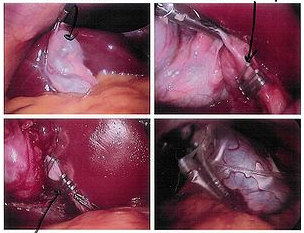
Laparoscopic Cholecystectomy as seen through laparoscope
Q. What are the symptoms of gallstones ?
Symptoms caused by gallstones are typically pain in the abdomen, usually right under the right ribcage and sometimes right under the breastbone. When this pain comes and goes, often after eating fatty or spicy food, and is due to gallstones, the condition is called "biliary colic." When the pain persists more than a few hours and keeps getting worse, it is called "cholecystitis."
Nausea and a bloating sensation are also common with gallstones, and yellow jaundice of the skin may develop. Jaundice is a sign of a gallstone that may have escaped the gallbladder and is now wreaking havoc farther on down the digestive system. This can lead to severe complications, like pancreatitis, or inflammation of the pancreas.
Cholecystectomy is the surgical removal of the gallbladder, which is located in the abdomen beneath the right side of the liver. Gallbladder problems are usually the result of gallstones. These stones may block the flow of bile from your gallbladder, causing the organ to swell. Other causes include cholecystitis (inflammation of the gallbladder) and cholangitis (inflammation of the bile duct). Gall stanes are commonly associated with excessive weight. Candiates that have undergone gastric surgery carry a higher risk of developing gallstones.
Reasons for Procedure
A cholecystectomy is done to remove a diseased or damaged gallbladder typically caused by infection or inflammation.
Various medical conditions can cause infection or inflammation of the gallbladder. Sometimes, for example, hard gallstones form in the gallbladder. These stones can slip into the narrow bile ducts, obstructing them. Gallstones (cholelithiasis) can cause inflammation and infection of the gallbladder (cholecystitis), pain, fever, nausea, jaundice , and difficulty digesting fatty foods.
operation
Your surgeon will make two or three small cuts (about 5-10mm long) on the skin, above, or just below, your navel.
Using a hollow needle, passed through or near your navel, carbon dioxide gas is pumped into the abdomen. This creates more room for your surgeon to work in and makes it easier to see the internal organs.
The laparoscope (a long, thin telescope with a light and camera lens at the tip) is then passed through one of the cuts. Your surgeon will examine the internal organs by looking directly through the laparoscope, or at pictures it sends to a video screen.
Specially adapted surgical instruments are passed through the other cuts to help move the internal structures so that your surgeon can see around them and to cut and remove the gall bladder. X-ray pictures may be taken to look at the bile duct during the operation, so that your surgeon can find out if any gallstones are blocking the bile duct.
Afterwards, the instruments are removed and the gas is allowed to escape through the laparoscope. The skin cuts are closed with dissolvable stitches and covered with a dressing. The operation takes 60 to 90 minutes.
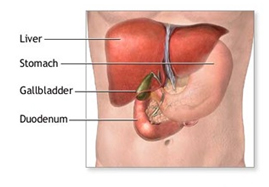
Cholecystectomy is the surgical removal of the gallbladder, a small pear-shaped sac that is located directly beneath the liver in the upper right side of the abdomen. The gallbladder's main function is to store bile, which is produced by the liver, and to release it as needed for digestion. The gallbladder's function is important, but it is not an essential organ.
Surgical removal is the most common therapy for gallbladder disorders. Gallstones (small, solid formations composed of cholesterol and bile salts) can cause problems in the gallbladder and the entire biliary system, including the pancreas.
They are often responsible for very painful and potentially serious inflammation of the gallbladder called acute cholecystitis. Cholecystectomy is the treatment of choice for this condition. Over 500,000 of these procedures are performed each year in the United States.
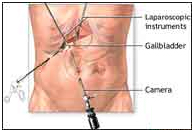
Surgical Procedures
Two procedures are utilized to surgically remove the gallbladder: open cholecystectomy and laparoscopic cholecystectomy. The laparoscopic method is utilized more frequently, but some patients, particularly if they are obese, have a bleeding disorder, are pregnant and near the due date, or have extensive scarring from previous abdominal surgeries are not candidates. The choice of procedure is made on an individual basis.
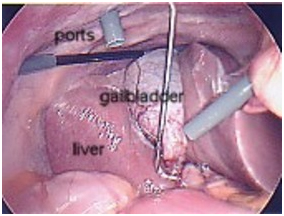
Open Cholecystectomy
The surgery is performed under general anesthesia, which renders the patient unconscious. After the anesthesia is administered, the abdomen is cleaned with an antiseptic solution to reduce the risk for infection. The surgeon makes a 4- to 6-inch incision in the right upper portion of the abdomen. The liver is lifted out of the way and the gallbladder is carefully removed. The incision is closed and sutured.
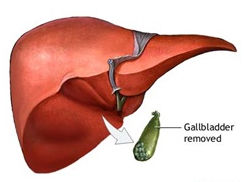
The disadvantages of this procedure are longer hospitalization and recovery period, significant postoperative pain, and a large scar. However, the surgery is safe and carries a low risk for complications. Open cholecystectomy is used when laparoscopy is unsuitable for the patient.
Laparoscopic Cholecystectomy
Laparoscopic cholecystectomy is the method of choice, provided the patient meets the criteria. The surgery is performed using general anesthesia and the abdomen is cleaned with an antiseptic solution. Instead of making one large incision, the surgeon makes four tiny cuts in the abdomen. One incision is made right under the navel (umbilicus) and a laparoscope is inserted. The laparoscope is a miniature telescope attached to a camera, and through its lens the surgeon can see the interior of the abdomen.
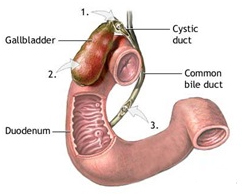
Instruments are inserted through the other incisions to perform the surgery. The gallbladder is cut free and pulled through one of the incisions. Before removing it, the surgeon sometimes shrinks the gallbladder by suctioning out the bile. Incisions are sutured or stapled closed at the end of the surgery. The procedure usually takes 30 to 60 minutes.
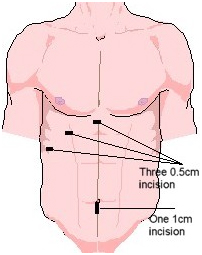
Benefits
Gallbladder removal will relieve pain, treat infection, and in most cases stop gallstones from coming back. The risks of not having surgery are the possibility of worsening symptoms, infection, or bursting of the gallbladder.
Laparoscopic gallbladder surgery requires a shorter hospital stay; usually the patient is home within 24 hours. In some cases you may need to stay overnight. In contrast, patients undergoing open cholecystectomy are often in the hospital three to seven days.
Risk Factors
- Age: 60 or older
- Pregnancy
- Obesity
- Smoking
- Excess stress
- Malnutrition
- Recent or chronic illness
- Diabetes
- Heart or lung problems
- Bleeding disorders
- Alcoholism
- Use of certain medications, including blood pressure pills, muscle relaxants, tranquilizers, sleeping pills, insulin, steroids, sedatives, and hypnotic agents
- Use of street drugs, including LSD, hallucinogens, marijuana, and cocaine
Complication
Complications are rare and may include : -
- Bleeding & infection may occur but is rare with experienced surgeons.
- In a few cases, the gallbladder cannot be safely removed by laparoscopy. Standard open abdominal surgery is then immediately performed.
- Nausea and vomiting may occur after the surgery.
- Injury to the bile ducts, blood vessels, or intestine can occur, requiring corrective surgery.
Alternative Names
Open cholecystectomy; Laparoscopic cholecystectomy; Cholecystectomy
The list of of General Surgery Hospitals in India is as follows : -
 |
Apollo Hospitals, Bangalore, India |
 |
Apollo Hospital, Chennai, India |
 |
Apollo Hospitals, Hyderabad, India |
 |
Indraprastha Apollo Hospital, Delhi, India |
 |
Apollo Gleneagles Hospital, Kolkata, India |
 |
Apollo Hospital, Goa, India |
 |
Wockhardt Hospital, Bangalore India |
 |
Wockhardt Hospital, hyderabad, India |
 |
Wockhardt Hospital, Mumbai, India |
 |
Wockhardt Hospital and Kidney Institute, Kolkata, India |
 |
Fortis Hospital, Delhi, India |
 |
Fortis Hospital, Mohali, India |
 |
Fortis Hospital, Noida, India |
 |
Manipal Hospital, Bangalore, India |
 |
MIOT Hospital, Chennai, India |
 |
Sparsh Hospital, Bangalore, India |
 |
Narayana Cancer Hospital, Bangalore, India |
 |
Artemis Hospital, Gurgaon ( Delhi ) , India |
 |
Max Super Specialty hospital, Delhi, India |
 |
BGS Global Hospital, Bangalore, India |
 |
BGS Global Hospital, Chennai, India |
 |
BGS Global Hospital, Hyderabad, India |
|
For more information, medical assessment and medical quote
send your detailed medical history and medical reports
as email attachment to
Email : - info@wecareindia.com
Call: +91 9029304141 (10 am. To 8 pm. IST)
(Only for international patients seeking treatment in India)
| | |
|
